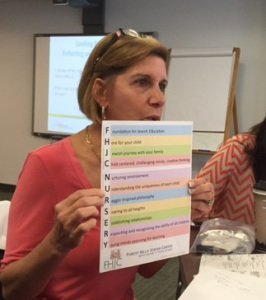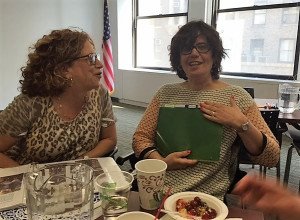Leading for Change: Looking back at Year 1 in Project LEAD
For about a year now several early childhood directors and teacher leaders involved in The Jewish Education Project’s Project LEAD initiative have been pushing themselves to spread innovative practices more widely throughout their school. The end goal is to lead systemic change towards Reggio and nature-based education in their schools. Over the course of the year they’ve been asked to create, reflect, rinse and repeat. They've practiced creating shared visions with stakeholders. They've learned what it takes to become a learning organization. And they've been introduced to steps in the Design Thinking process, including drafting “How Might We” questions for solving problems identified in their schools.
Being a "change agent" in your school isn’t easy. It’s about thinking deeply while acting swiftly! It's making changes while the bus is still running and everyone knows an early childhood center is not a slow moving bus. It’s fast and time goes by very quickly between September and June. So quickly in fact, that if you don’t act and launch new ideas early it probably won’t get done at all. So how did these change agents manage to balance it all? What have they learned about being leaders for change this past year? And where can they see those changes happening?
For their last seminar of the year, held June 1, 2016, the participants were given homework ahead of time. They were asked to reflect on their year and bring with them two artifacts – one symbolizing a success and one that symbolized an epic failure. Did they rise to the challenge? Were they comfortable sharing? Could they find success stories? And how might they interpret their failures?
Reasons to cheer:
- The creation of an atelier (an art space devoted to displaying the work of children) that showcases the children's study and learning over the course of 5 weeks. The picture below shows the beautiful creations and displays that have provoked more meaningful conversations than ever before.

- Teachers being more present and listening. Examples illustrated how teachers helped support further explorations by the children which lead towards more in-depth engagement and learning by the children.
- Using a new platforms, such as Instagram, to communicate children's learning with parents.
- The use of a wild space near and around a school for walks. This new routine led these teachers to become better observers, noting how the children interact differently in nature than they do in the classroom. These nature walks are also supporting more student led investigations.
- The drafting of a set of school values by stakeholders in using the name of the school as an acronym. Some of the statements below include: N - Nurturing environment; R - Respecting and recognizing the ability of all children; J - Jewish journey with your family; F - Foundation for Jewish education.

- Teachers becoming better at recognizing small but meaningful moments in their classrooms - both as they are happening and through photographs.
- Teachers learning how to step back and think more consciously about projects that have been replicated for years. Pushing outside the comfort zone.
Their ongoing challenges:
Challenges being experienced by the teachers in this process (as expressed by both directors and teacher leaders):
- Teachers feeling newly judged
- Teachers seeing themselves as professionals
- Teachers adopting new practices with more consistency
- Teachers letting go of old habits
- Teachers becoming more self-directed
Challenges the directors feel they are facing:
- Finding ways to articulate a clear vision for their teachers
- Finding time for teachers to collaborate & observe each other
- Communicating these new values and ideals with parents
- Shifting to new communication streams (technology) for today’s parents
- Projecting a new persona (as leader and expert)
The power of reflection:
The first thing we learned from these brave directors and teacher leaders is that articulating anything as an epic failure just felt icky. While much has been written about “failing forward” in recent years, including by my own colleagues, we’re still inclined to a put a positive spin on our efforts to avoid feeling uncomfortable, at least in the short term. And while they were asked to share both a success and a failure, their focus and enthusiasm was indeed on their successes - even if they could see a long road still ahead.

The second thing we learned was that after a challenging and difficult year juggling schedules. attending seminars, working with their coaches, and answering to the demands of the project itself, the participants actually enjoyed taking a moment to look back at their year. In some cases they needed this exercise to get an even clearer picture of exactly what had been accomplished given their extended time and effort. One educator shared at the seminar that what she had learned wasn't actually "revealed" to her until this very moment.
With Project LEAD continuing for another year, the second half of Seminar #3 was spent laying the ground work for the coming year. Check back soon to read how these brave change agents created action plans for their schools - focused this time on very specific (and measurable) goals!
To learn more about Project LEAD, contact Bryna Leider, at bleider@JewishEdProject.org
Shariee Calderone is Sr. Education Consultant for Early Childhood and Family Engagement at The Jewish Education Project.